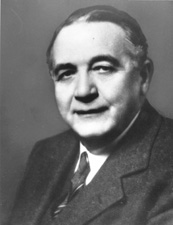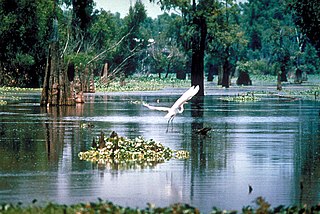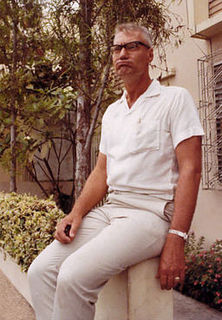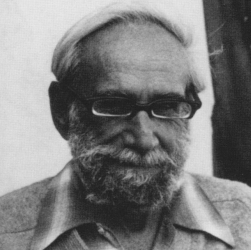Related Research Articles

A marsh is a wetland that is dominated by herbaceous rather than woody plant species. Marshes can often be found at the edges of lakes and streams, where they form a transition between the aquatic and terrestrial ecosystems. They are often dominated by grasses, rushes or reeds. If woody plants are present they tend to be low-growing shrubs, and then sometimes called carrs. This form of vegetation is what differentiates marshes from other types of wetland such as swamps, which are dominated by trees, and mires, which are wetlands that have accumulated deposits of acidic peat.

John Holmes Overton Sr., was an attorney and Democratic US Representative and US Senator from Louisiana. His nephew, Thomas Overton Brooks, was also a US representative, from the Shreveport-based 4th district of Louisiana.
Hydrobiology is the science of life and life processes in water. Much of modern hydrobiology can be viewed as a sub-discipline of ecology but the sphere of hydrobiology includes taxonomy, economic biology, industrial biology, morphology, physiology etc. The one distinguishing aspect is that all relate to aquatic organisms. Much work is closely related to limnology and can be divided into lotic system ecology and lentic system ecology.

The wetlands of Louisiana are water-saturated coastal and swamp regions of southern Louisiana.

Marine ecosystems are the largest of Earth's aquatic ecosystems and are distinguished by waters that have a high salt content. These systems contrast with freshwater ecosystems, which have a lower salt content. Marine waters cover more than 70% of the surface of the Earth and account for more than 97% of Earth's water supply and 90% of habitable space on Earth. Marine ecosystems include nearshore systems, such as the salt marshes, mudflats, seagrass meadows, mangroves, rocky intertidal systems and coral reefs. They also extend outwards from the coast to include offshore systems, such as the surface ocean, pelagic ocean waters, the deep sea, oceanic hydrothermal vents, and the sea floor. Marine ecosystems are characterized by the biological community of organisms that they are associated with and their physical environment.
Robert Jocelyn Barham is an American large-scale farmer from Morehouse Parish in northern Louisiana who served for all eight years under former Governor Bobby Jindal as the secretary of his state's Department of Wildlife and Fisheries. He is a Republican former member of the Louisiana State Senate for District 33, all of which border Arkansas in the northeastern section of his state.

Harold Carl Otto Loesch was a marine biologist and oceanographer who is credited with being the first to examine the Mobile Bay jubilee in an academic journal(Ecology).paper

The Virginia Institute of Marine Science (VIMS) is one of the largest marine research and education centers in the United States. Founded in 1940, VIMS is unique among marine science institutions in its legal mandate to provide research, education, and advisory service to government, citizens, and industry. Funding for VIMS comes from the Commonwealth of Virginia, grants and contracts from federal and state agencies, and private giving. The School of Marine Science (SMS) at VIMS is the graduate school in marine science for the College of William & Mary. Offering both M.S. and Ph.D. degrees in marine science, the school has 57 faculty members, an enrollment of 80-100 students, and includes 4 academic departments. VIMS' main campus is located in Gloucester Point, Virginia.

The rainwater killifish is a small silvery fish with yellow flashes and diamond shaped scales that is widespread from Cape Cod, Massachusetts, through to Tampico, Mexico. It is commonly found in large numbers in fresh to brackish estuarine environments. It feeds on tiny crustaceans, mosquito larvae, small worms, and mollusks. It can reach up to 62 mm.

The full relationship between fisheries and climate change is difficult to explore due to the context of each fishery and the many pathways that climate change affects. However, there is strong global evidence for these effects. Rising ocean temperatures and ocean acidification are radically altering marine aquatic ecosystems, while freshwater ecosystems are being impacted by changes in water temperature, water flow, and fish habitat loss. Climate change is modifying fish distribution and the productivity of marine and freshwater species.
St. Andrews Biological Station is a Fisheries and Oceans Canada research centre located on Brandy Cove Road in St. Andrews, New Brunswick.
Caroline Wogan Durieux was an American lithographer, and Professor Emeritus of Fine Arts at Louisiana State University.

Martin David Burkenroad was an American marine biologist. He specialized in decapod crustaceans and fisheries science.

Salvinia minima is a species of aquatic, floating fern that grows on the surface of still waterways. It is usually referred to as common salvinia or water spangles. Salvinia minima is native to South America, Mesoamerica, and the West Indies and was introduced to the United States in the 1920s-1930s. It is classified as an invasive species internationally and can be detrimental to native habitats. This species is similar to but should not be confused with giant salvinia, Salvinia molesta.

Voorhies Trahan was, along with his second wife Aloncel "Ciel" Trahan (Credeur), instrumental in pioneering the crawfish farming industry in Louisiana rice fields.
Leslie Lloyd Glasgow was a Louisiana State University professor and advocate of conservation of natural resources who was director of the Louisiana Wildlife and Fisheries Commission from 1966 to 1968 during the administration of Governor John McKeithen and then from 1969 to 1970 the assistant U.S. Secretary of the Interior under Walter Hickel, with duties over Fish, Wildlife, Parks, and Marine Resources, in the first half of the first term of U.S. President Richard M. Nixon.

Coastal Erosion in Louisiana is the process of steady depletion of wetlands along the state's coastline in marshes, swamps, and barrier islands, particularly affecting the alluvial basin surrounding the mouth of the Mississippi River at the foot of the Gulf of Mexico on the Eastern half of the state's coast. In the last century, Southeast Louisiana has lost a large portion of its wetlands and is expected to lose more in the coming years, with some estimates claiming wetland losses equivalent to up to 1 football field per hour. One consequence of coastal erosion is an increased vulnerability to hurricane storm surges, which affects the New Orleans metropolitan area and other communities in the region. The state has outlined a comprehensive master plan for coastal restoration and has begun to implement various restoration projects such as fresh water diversions, but certain zones will have to be prioritized and targeted for restoration efforts, as it is unlikely that all depleted wetlands can be rehabilitated.
Gordon Gunter was an American marine biologist and fisheries scientist. He is noted for his pioneering study of fisheries in the northern Gulf of Mexico, a topic to which he devoted his entire professional life over a career spanning 60 years. His own research, and that of the scientists under his direction, established an understanding of the ecology, comparative physiology of the plant and animal life, and commercial fisheries of the region, and he coined the phrase "fertile fisheries crescent" to refer to Mississippi Sound and adjacent waters along the United States Gulf Coast. He also pioneered the study of the comparative physiology of shellfish and fish.
Royal Dallas Suttkus was an icthylogist and biology professor responsible for creating the Royal D. Suttkus Fish Collection, one of the largest of its kind. It houses approximately 7 million post-larval specimens of fishes. The collection is part of the Tulane University Biodiversity Research Institute and the Tulane University Museum of Natural History.
Katherine “Frin” Ross is a British marine biologist and conservationist who has worked extensively in the Falkland Islands and South Georgia and the South Sandwich Islands. She previously served as Marine and Fisheries Officer for the Government of South Georgia and the South Sandwich Islands.
References
- ↑ 2008. "About Percy Viosca, Jr." from the Percy Viosca Jr. Collection. Special Collections, Library of Louisiana State University. Accessed September 19, 2013. "Archived copy". Archived from the original on 2013-09-21. Retrieved 2013-09-19.CS1 maint: archived copy as title (link)
- ↑ Louisiana Ecology and Conservation: The Percy Viosca Jr. Collection, LOUISiana Digital Library, Baton Rouge, La. <accessed 26 January 2015) <http://www.louisianadigitallibrary.org/cdm/landingpage/collection/LSU_PVC/>
- ↑ Tulane Environmental Law Journal The Reckoning: Oil and Gas Development in the Louisiana Coastal Zone (pp. 198)- Retrieved 2017-11-12